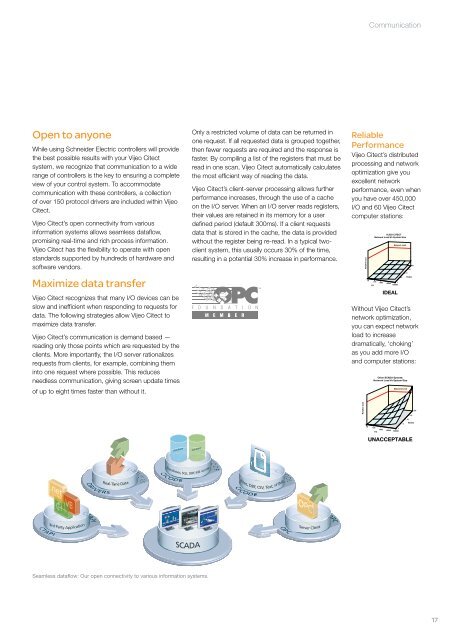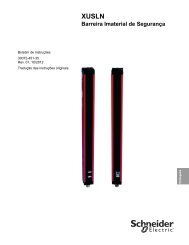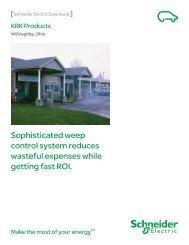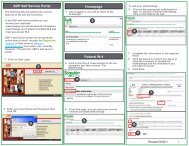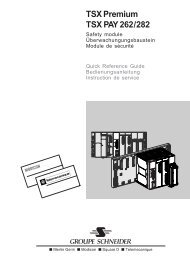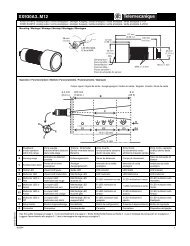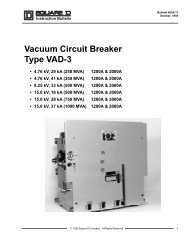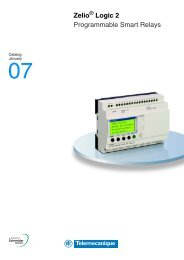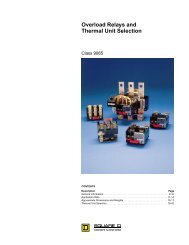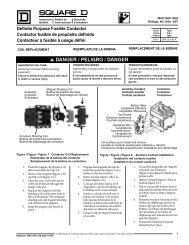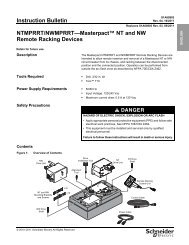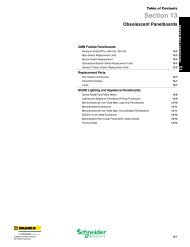Vijeo Citect Technical Overview - Square D
Vijeo Citect Technical Overview - Square D
Vijeo Citect Technical Overview - Square D
You also want an ePaper? Increase the reach of your titles
YUMPU automatically turns print PDFs into web optimized ePapers that Google loves.
Open to anyone<br />
While using Schneider Electric controllers will provide<br />
the best possible results with your <strong>Vijeo</strong> <strong>Citect</strong><br />
system, we recognize that communication to a wide<br />
range of controllers is the key to ensuring a complete<br />
view of your control system. To accommodate<br />
communication with these controllers, a collection<br />
of over 150 protocol drivers are included within <strong>Vijeo</strong><br />
<strong>Citect</strong>.<br />
<strong>Vijeo</strong> <strong>Citect</strong>’s open connectivity from various<br />
information systems allows seamless dataflow,<br />
promising real-time and rich process information.<br />
<strong>Vijeo</strong> <strong>Citect</strong> has the flexibility to operate with open<br />
standards supported by hundreds of hardware and<br />
software vendors.<br />
Maximize data transfer<br />
<strong>Vijeo</strong> <strong>Citect</strong> recognizes that many I/O devices can be<br />
slow and inefficient when responding to requests for<br />
data. The following strategies allow <strong>Vijeo</strong> <strong>Citect</strong> to<br />
maximize data transfer.<br />
<strong>Vijeo</strong> <strong>Citect</strong>’s communication is demand based —<br />
reading only those points which are requested by the<br />
clients. More importantly, the I/O server rationalizes<br />
requests from clients, for example, combining them<br />
into one request where possible. This reduces<br />
needless communication, giving screen update times<br />
of up to eight times faster than without it.<br />
Only a restricted volume of data can be returned in<br />
one request. If all requested data is grouped together,<br />
then fewer requests are required and the response is<br />
faster. By compiling a list of the registers that must be<br />
read in one scan, <strong>Vijeo</strong> <strong>Citect</strong> automatically calculates<br />
the most efficient way of reading the data.<br />
<strong>Vijeo</strong> <strong>Citect</strong>’s client-server processing allows further<br />
performance increases, through the use of a cache<br />
on the I/O server. When an I/O server reads registers,<br />
their values are retained in its memory for a user<br />
defined period (default 300ms). If a client requests<br />
data that is stored in the cache, the data is provided<br />
without the register being re-read. In a typical twoclient<br />
system, this usually occurs 30% of the time,<br />
resulting in a potential 30% increase in performance.<br />
Seamless dataflow: Our open connectivity to various information systems.<br />
Seamless dataflow; our open connectivity to various information systems<br />
Reliable<br />
Performance<br />
<strong>Vijeo</strong> <strong>Citect</strong>’s distributed<br />
processing and network<br />
optimization give you<br />
excellent network<br />
performance, even when<br />
you have over 450,000<br />
I/O and 60 <strong>Vijeo</strong> <strong>Citect</strong><br />
computer stations:<br />
Relative load<br />
VIJEO CITECT<br />
Network Load Vs System Size<br />
1<br />
10<br />
100<br />
1000<br />
I/O<br />
1<br />
10000<br />
100000<br />
IDEAL<br />
Network Limit<br />
20<br />
15<br />
10<br />
5 Nodes<br />
Without <strong>Vijeo</strong> <strong>Citect</strong>’s<br />
network optimization,<br />
you can expect network<br />
load to increase<br />
dramatically, ‘choking’<br />
as you add more I/O<br />
and computer stations:<br />
Relative load<br />
1<br />
10<br />
Communication<br />
Other SCADA Systems<br />
Network Load Vs System Size<br />
Network Limit<br />
20<br />
15<br />
10<br />
Nodes<br />
5<br />
100<br />
1<br />
1000<br />
10000<br />
I/O<br />
100000<br />
UNACCEPTABLE<br />
17


